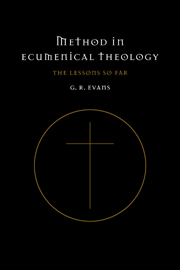Book contents
- Frontmatter
- Contents
- Dedication
- Preface
- Abbreviations
- Introduction: the ‘winter of ecumenism’?
- I What is ecumenical theology?
- 2 Changing attitudes and stages in ecumenism
- 3 Communication and dialogue
- 4 Ecumenical language
- 5 Historical method
- 6 The process in close-up
- 7 Ecumenical reception
- Conclusion
- Index
I - What is ecumenical theology?
Published online by Cambridge University Press: 02 September 2009
- Frontmatter
- Contents
- Dedication
- Preface
- Abbreviations
- Introduction: the ‘winter of ecumenism’?
- I What is ecumenical theology?
- 2 Changing attitudes and stages in ecumenism
- 3 Communication and dialogue
- 4 Ecumenical language
- 5 Historical method
- 6 The process in close-up
- 7 Ecumenical reception
- Conclusion
- Index
Summary
THE RULES
Ecumenical theology has both to look towards and maintain unity; and to counter division. It has in these respects the traditional responsibilities of the theological exercises of earlier ages, when these ‘positive’ and ‘negative’ aspects of the theologian's task were already clear. It also has a third task unique to, and novel in, ecumenical theology. It has to make what appear to be parallel lines meet. It has to make theology done in confessional and ecclesial separation a common theological exercise. This new role will be a principal theme of this study.
It is as controversial in its different way as the two older and more traditional tasks. Ecumenism gets two apparently mutually paradoxical kinds of negative response. The first is really no response at all. It is apathy. Those in the separated churches say ‘We are very well as we are. We have all we need in our church to be Christians together.’ This is of course true. The Church can be fully the Church wherever it is. But it is also obviously the case that something is missing in a Church which cannot feel itself fully at one with other Christians in their communities. The other response is to acknowledge a sense of the threat posed to separate Christian identity by ecumenism.
I shall be arguing that theology done ecumenically is a discipline in its own right, and one whose methods and principles we now need urgently to develop.
- Type
- Chapter
- Information
- Method in Ecumenical TheologyThe Lessons So Far, pp. 19 - 39Publisher: Cambridge University PressPrint publication year: 1996



